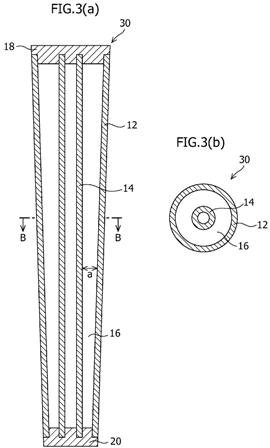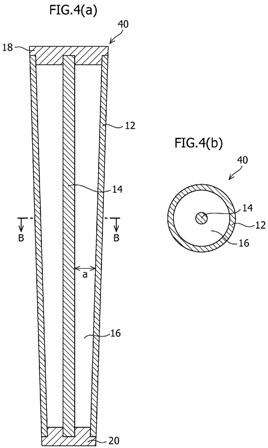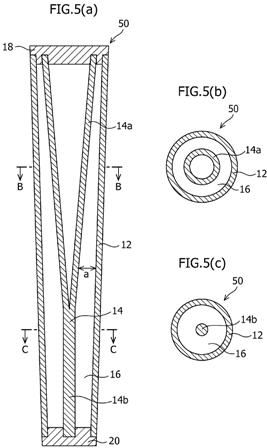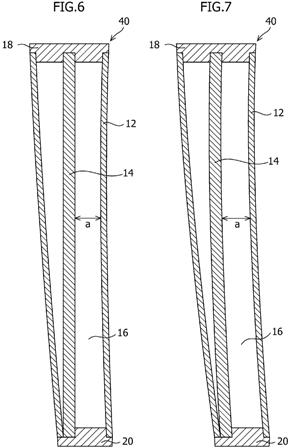Has Bridgestone Invented the Golf Shaft of the Future?
Interesting golf shaft patent applications don’t come along everyday, which is why a Bridgestone patent application that published today got my attention. The application basically discloses a shaft within a shaft. Confused? Check this out.




The images come from a Bridgestone patent application that published today as US Pub. No. 20110172025 titled “Golf Club Shaft and Golf Club,” which describes the invention as:
The application goes on to explain:
What do you thing, are golfers ready for a single shaft that accommodates both slow swing speeds and fast swing speeds?
Dave Dawsey - Monitoring Golf Shaft Patent Applications
PS – click HERE to read about more golf shaft inventions




The images come from a Bridgestone patent application that published today as US Pub. No. 20110172025 titled “Golf Club Shaft and Golf Club,” which describes the invention as:
A golf club shaft includes an outer shaft and an inner shaft disposed in a hollow portion of the outer shaft. A void portion is formed between the outer shaft and the inner shaft. The golf club shaft has a double structure including the outer shaft and the inner shaft. This allows both of the shafts to integrally operate and also allows one of the shafts to primarily operate.
The application goes on to explain:
[0007] The present invention has been made under the above circumstances. The present invention is a golf club shaft which has a double structure including an outer shaft and an inner shaft, and which allows both of the shafts to integrally operate and also allows one of the shafts to primarily operate. An object of the present invention is to provide a golf club shaft that exhibits excellent performance by these operations of such shafts and to provide a golf club using the golf club shaft.
[0008] In order to achieve the above object, the present invention provides a golf club shaft including: an outer shaft having a hollow portion; and an inner shaft disposed in the hollow portion of the outer shaft. In the golf club shaft, a void portion is formed between the outer shaft and the inner shaft. Furthermore, the present invention provides a golf club including the golf club shaft according to the present invention described above.
[0009] In the golf club shaft of the present invention, the outer shaft and the inner shaft are separate bodies from each other. In addition, the outer shaft and the inner shaft are apart from each other. Thereby, the outer shaft and the inner shaft can operate independently. Thus, when a golfer slow in head speed swings the golf club of the present invention, the outer shaft flexes, but the inner shaft does not flex at all or flexes little depending on the head speed. Accordingly, the shaft as a whole is flexible and suitable for a golfer slow in head speed. The flexibility of the shaft is utilized to increase the head speed or to increase the launch angle of a ball; thereby, the driving distance can be increased. In contrast, when a golfer fast in head speed swings the golf club of the present invention, both of the shafts flex together greatly. Accordingly, the shaft as a whole is stiff and suitable for a golfer fast in head speed. The stiffness of the shaft is utilized to increase the initial speed of a ball; thereby, the driving distance can be increased.
[0042] Next, operations and effects of the shaft of the present invention will be described with reference to FIGS. 6 and 7. FIG. 6 is an explanatory view showing how the shaft 40 of the third embodiment flexes when a golfer slow in head speed swings a golf club with the shaft. As shown in FIG. 6, the outer shaft 12 flexes, but the inner shaft 14 does not flex at all or flexes little depending on the head speed. As a result, the shaft 40 is flexible and suitable for a golfer slow in head speed. The flexibility of the shaft 40 is utilized to increase the launch angle of a ball; thereby, the driving distance can be increased.
[0043] FIG. 7 is an explanatory view showing how the shaft 40 of the third embodiment flexes when a golfer fast in head speed swings the golf club with the shaft. As shown in FIG. 7, both of the outer shaft 12 and the inner shaft 14 flex in accordance with the head speed, although the degree of the flexure varies depending on the head speed. As a result, the shaft 40 is stiff and suitable for a golfer fast in head speed. The stiffness of the shaft is utilized to increase the initial speed of a ball; thereby, the driving distance can be increased. Note that, in this case also, the outer shaft 12 plays a major role in the shaft 40, while the inner shaft 14 plays a minor role.
What do you thing, are golfers ready for a single shaft that accommodates both slow swing speeds and fast swing speeds?
Dave Dawsey - Monitoring Golf Shaft Patent Applications
PS – click HERE to read about more golf shaft inventions


Comments